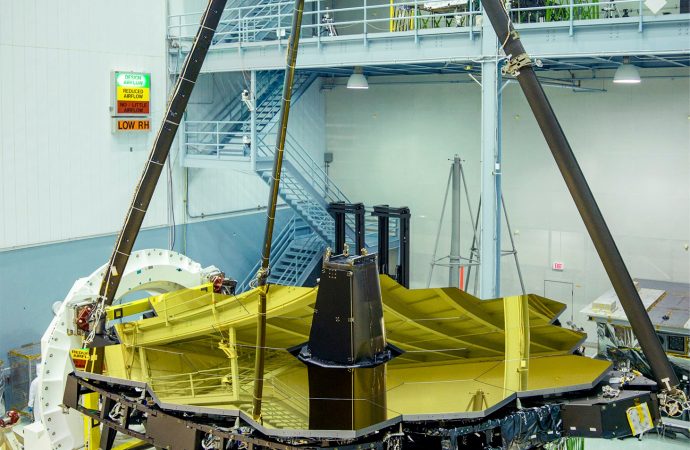NASA engineers recently unveiled the giant golden mirror of NASA’s James Webb Space Telescope as part of the integration and testing of the infrared telescope.
The 18 mirrors that make up the primary mirror were individually protected with a black covers when they were assembled on the telescope structure. Now, for the first time since the primary mirror was completed, the covers have been lifted.
Standing tall and glimmering gold inside NASA’s Goddard Space Flight Center’s clean room in Greenbelt, Maryland, this mirror will be the largest yet sent into space. Currently, engineers are busy assembling and testing the other pieces of the telescope.
Scientists from around the world will use this unique observatory to capture images and spectra of not only the first galaxies to appear in the early universe over 13.5 billion years ago, but also the full range of astronomical sources such as star forming nebulae, exoplanets, and even moons and planets within our own Solar System. To ensure the mirror is both strong and light, the team made the mirrors out of beryllium. Each mirror segment is about the size of a coffee table and weighs approximately 20 kilograms (46 pounds). A very fine film of vaporized gold coats each segment to improve the mirror’s reflection of infrared light. The fully assembled mirror is larger than any rocket so the two sides of it fold up. Behind each mirror are several motors so that the team can focus the telescope out in space.
This widely anticipated telescope will soon go through many rigorous tests to ensure it survives its launch into space. In the next few months, engineers will install other key elements, and take additional measurements to ensure the telescope is ready for space.
The James Webb Space Telescope is the scientific successor to NASA’s Hubble Space Telescope. It will be the most powerful space telescope ever built. Webb will study many phases in the history of our universe, including the formation of solar systems capable of supporting life on planets similar to Earth, as well as the evolution of our own solar system. It’s targeted to launch from French Guiana aboard an Ariane 5 rocket in 2018. Webb is an international project led by NASA with its partners, ESA (European Space Agency) and the Canadian Space Agency.
Source: NASA

































Leave a Comment
You must be logged in to post a comment.